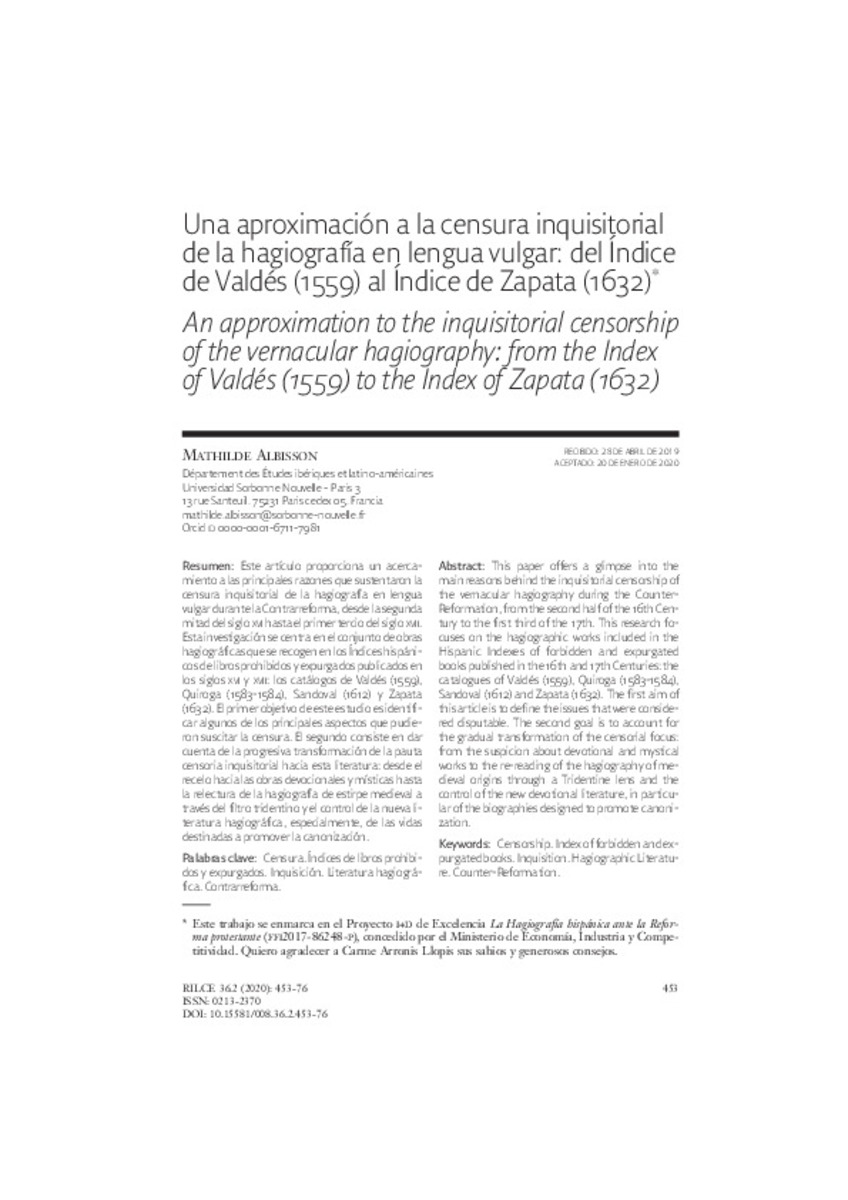Full metadata record
| DC Field | Value | Language |
|---|---|---|
| dc.creator | Albisson, M. (Mathilde) | - |
| dc.date.accessioned | 2019-04-29 | - |
| dc.date.accessioned | 2021-08-18T10:16:33Z | - |
| dc.date.available | 2021-08-18T10:16:33Z | - |
| dc.date.issued | 2019 | - |
| dc.identifier.citation | Albisson, M. (Mathilde). "Una aproximación a la censura inquisitorial de la hagiografía en lengua vulgar: del Índice de Valdés (1559) al Índice de Zapata (1632)". Rilce. Revista de Filología Hispánica. 36 (2), 2019, 453 - 76 | es |
| dc.identifier.issn | 0213-2370 | - |
| dc.identifier.uri | https://hdl.handle.net/10171/61337 | - |
| dc.description.abstract | This paper offers a glimpse into the main reasons behind the inquisitorial censorship of the vernacular hagiography during the Counter- Reformation, from the second half of the 16th Century to the first third of the 17th. This research focuses on the hagiographic works included in the Hispanic Indexes of forbidden and expurgated books published in the 16th and 17th Centuries: the catalogues of Valdés (1559), Quiroga (1583-1584), Sandoval (1612) and Zapata (1632). The first aim of this article is to define the issues that were considered disputable. The second goal is to account for the gradual transformation of the censorial focus: from the suspicion about devotional and mystical works to the re-reading of the hagiography of medieval origins through a Tridentine lens and the control of the new devotional literature, in particular of the biographies designed to promote canonization. | en_US |
| dc.description.abstract | Este artículo proporciona un acercamiento a las principales razones que sustentaron la censura inquisitorial de la hagiografía en lengua vulgar durante la Contrarreforma, desde la segunda mitad del siglo XVI hasta el primer tercio del siglo XVII. Esta investigación se centra en el conjunto de obras hagiográficas que se recogen en los Índices hispánicos de libros prohibidos y expurgados publicados en los siglos XVI y XVII: los catálogos de Valdés (1559), Quiroga (1583-1584), Sandoval (1612) y Zapata (1632). El primer objetivo de este estudio es identificar algunos de los principales aspectos que pudieron suscitar la censura. El segundo consiste en dar cuenta de la progresiva transformación de la pauta censoria inquisitorial hacia esta literatura: desde el recelo hacia las obras devocionales y místicas hasta la relectura de la hagiografía de estirpe medieval a través del filtro tridentino y el control de la nueva literatura hagiográfica, especialmente, de las vidas destinadas a promover la canonización. | es_ES |
| dc.language.iso | spa | - |
| dc.publisher | Servicio de Publicaciones de la Universidad de Navarra | es_ES |
| dc.rights | info:eu-repo/semantics/openAccess | es_ES |
| dc.subject | Censura | - |
| dc.subject | Índices de libros prohibidos y expurgados | - |
| dc.subject | Inquisición | - |
| dc.subject | Literatura hagiográfica | - |
| dc.subject | Contrarreforma | - |
| dc.title | Una aproximación a la censura inquisitorial de la hagiografía en lengua vulgar: del Índice de Valdés (1559) al Índice de Zapata (1632) | es_ES |
| dc.title.alternative | An approximation to the inquisitorial censorship of the vernacular hagiography: from the Index of Valdés (1559) to the Index of Zapata (1632) | en_US |
| dc.type | info:eu-repo/semantics/article | es_ES |
| dc.identifier.doi | 10.15581/008.36.2.453-76 | - |
| dadun.citation.endingPage | 76 | - |
| dadun.citation.number | 2 | - |
| dadun.citation.publicationName | Rilce. Revista de Filología Hispánica | - |
| dadun.citation.startingPage | 453 | - |
| dadun.citation.volume | 36 | - |
Files in This Item:
Statistics and impact
Items in Dadun are protected by copyright, with all rights reserved, unless otherwise indicated.






